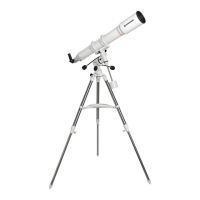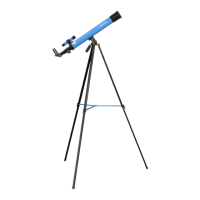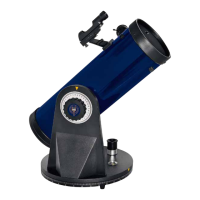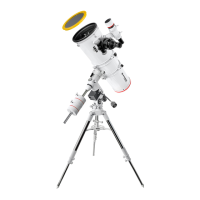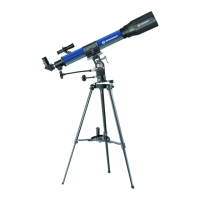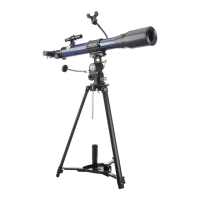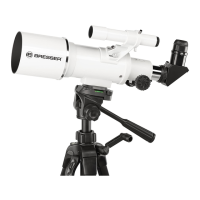Do you have a question about the Bresser AR-90 and is the answer not in the manual?
Overview of Messier series telescopes and their general capabilities.
Visual guide to the EXOS1 and EXOS2 equatorial mounts.
Introduces the Messier series and its purpose.
Explains the function of key telescope parts numbered 1 through 16.
Explains the function of key telescope parts numbered 17 through 38.
Useful tips and web links for astronomy enthusiasts.
Step-by-step guide for assembling the EXOS1 mount and telescope.
Step-by-step guide for assembling the EXOS2 mount and telescope.
How to balance the telescope for stable and smooth operation.
Guide to aligning the finder scope for accurate object acquisition.
Guidance on choosing eyepieces for optimal viewing magnification.
Basic techniques for manually observing celestial objects.
Tips for observing specific celestial bodies like the Moon.
Steps to orient the telescope mount for polar alignment.
Recommendations for telescope care, cleaning, and protection.
Step-by-step procedure for aligning mirrors in Newtonian telescopes.
Methods to assess the optical performance and condition.
Information on reaching customer service for assistance.
Explanation of Right Ascension and Declination systems for sky mapping.
Technique for finding celestial objects using telescope coordinate circles.
A list of city latitudes to aid in polar alignment setup.
Guide to using the polar alignment viewfinder for precise alignment.
Detailed instructions for accurate polar alignment of the mount.
Overview of astronomy, celestial bodies, and historical context.
Tips for observing the Moon, planets, and deep-sky objects.
Guidance on identifying constellations and navigating the night sky.
Explanation of scales and distances in space.
Chart showing constellations visible during winter.
Chart showing constellations visible during spring.
Chart showing constellations visible during summer.
Chart showing constellations visible during autumn.
Overview of Messier series telescopes and their general capabilities.
Visual guide to the EXOS1 and EXOS2 equatorial mounts.
Introduces the Messier series and its purpose.
Explains the function of key telescope parts numbered 1 through 16.
Explains the function of key telescope parts numbered 17 through 38.
Useful tips and web links for astronomy enthusiasts.
Step-by-step guide for assembling the EXOS1 mount and telescope.
Step-by-step guide for assembling the EXOS2 mount and telescope.
How to balance the telescope for stable and smooth operation.
Guide to aligning the finder scope for accurate object acquisition.
Guidance on choosing eyepieces for optimal viewing magnification.
Basic techniques for manually observing celestial objects.
Tips for observing specific celestial bodies like the Moon.
Steps to orient the telescope mount for polar alignment.
Recommendations for telescope care, cleaning, and protection.
Step-by-step procedure for aligning mirrors in Newtonian telescopes.
Methods to assess the optical performance and condition.
Information on reaching customer service for assistance.
Explanation of Right Ascension and Declination systems for sky mapping.
Technique for finding celestial objects using telescope coordinate circles.
A list of city latitudes to aid in polar alignment setup.
Guide to using the polar alignment viewfinder for precise alignment.
Detailed instructions for accurate polar alignment of the mount.
Overview of astronomy, celestial bodies, and historical context.
Tips for observing the Moon, planets, and deep-sky objects.
Guidance on identifying constellations and navigating the night sky.
Explanation of scales and distances in space.
Chart showing constellations visible during winter.
Chart showing constellations visible during spring.
Chart showing constellations visible during summer.
Chart showing constellations visible during autumn.
| Aperture | 90 mm |
|---|---|
| Focal Length | 900 mm |
| Focal Ratio | f/10 |
| Optical Design | Refractor |
| Mount Type | Altazimuth |
| Finderscope | 6x30 |
| Weight | 3.5 kg |
| Tripod Included | Yes |
| Eyepieces Included | 10mm, 25mm |
